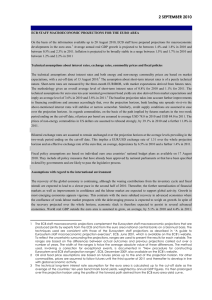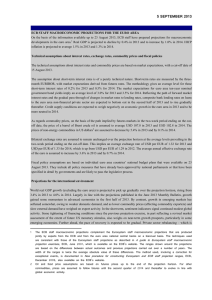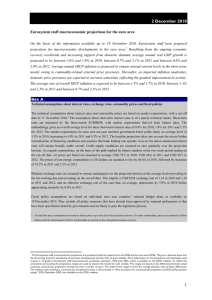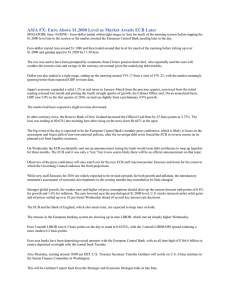8 March 2012
advertisement
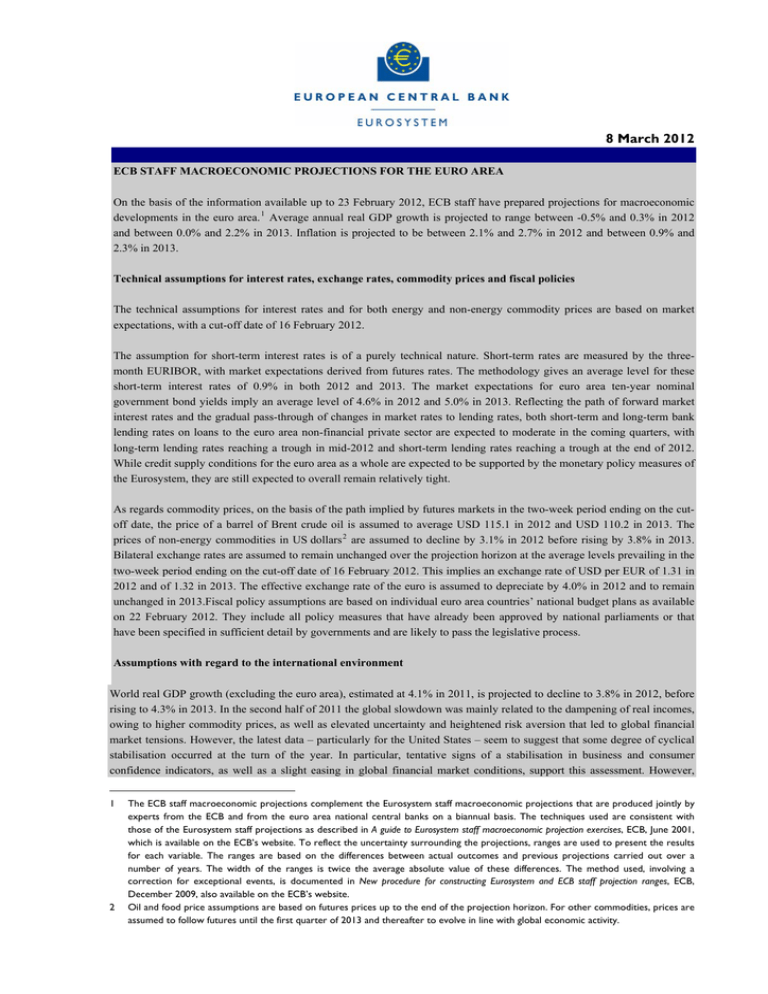
8 March 2012 ECB STAFF MACROECONOMIC PROJECTIONS FOR THE EURO AREA On the basis of the information available up to 23 February 2012, ECB staff have prepared projections for macroeconomic developments in the euro area. 1 Average annual real GDP growth is projected to range between -0.5% and 0.3% in 2012 and between 0.0% and 2.2% in 2013. Inflation is projected to be between 2.1% and 2.7% in 2012 and between 0.9% and 2.3% in 2013. Technical assumptions for interest rates, exchange rates, commodity prices and fiscal policies The technical assumptions for interest rates and for both energy and non-energy commodity prices are based on market expectations, with a cut-off date of 16 February 2012. The assumption for short-term interest rates is of a purely technical nature. Short-term rates are measured by the threemonth EURIBOR, with market expectations derived from futures rates. The methodology gives an average level for these short-term interest rates of 0.9% in both 2012 and 2013. The market expectations for euro area ten-year nominal government bond yields imply an average level of 4.6% in 2012 and 5.0% in 2013. Reflecting the path of forward market interest rates and the gradual pass-through of changes in market rates to lending rates, both short-term and long-term bank lending rates on loans to the euro area non-financial private sector are expected to moderate in the coming quarters, with long-term lending rates reaching a trough in mid-2012 and short-term lending rates reaching a trough at the end of 2012. While credit supply conditions for the euro area as a whole are expected to be supported by the monetary policy measures of the Eurosystem, they are still expected to overall remain relatively tight. As regards commodity prices, on the basis of the path implied by futures markets in the two-week period ending on the cutoff date, the price of a barrel of Brent crude oil is assumed to average USD 115.1 in 2012 and USD 110.2 in 2013. The prices of non-energy commodities in US dollars 2 are assumed to decline by 3.1% in 2012 before rising by 3.8% in 2013. Bilateral exchange rates are assumed to remain unchanged over the projection horizon at the average levels prevailing in the two-week period ending on the cut-off date of 16 February 2012. This implies an exchange rate of USD per EUR of 1.31 in 2012 and of 1.32 in 2013. The effective exchange rate of the euro is assumed to depreciate by 4.0% in 2012 and to remain unchanged in 2013.Fiscal policy assumptions are based on individual euro area countries’ national budget plans as available on 22 February 2012. They include all policy measures that have already been approved by national parliaments or that have been specified in sufficient detail by governments and are likely to pass the legislative process. Assumptions with regard to the international environment World real GDP growth (excluding the euro area), estimated at 4.1% in 2011, is projected to decline to 3.8% in 2012, before rising to 4.3% in 2013. In the second half of 2011 the global slowdown was mainly related to the dampening of real incomes, owing to higher commodity prices, as well as elevated uncertainty and heightened risk aversion that led to global financial market tensions. However, the latest data – particularly for the United States – seem to suggest that some degree of cyclical stabilisation occurred at the turn of the year. In particular, tentative signs of a stabilisation in business and consumer confidence indicators, as well as a slight easing in global financial market conditions, support this assessment. However, 1 2 The ECB staff macroeconomic projections complement the Eurosystem staff macroeconomic projections that are produced jointly by experts from the ECB and from the euro area national central banks on a biannual basis. The techniques used are consistent with those of the Eurosystem staff projections as described in A guide to Eurosystem staff macroeconomic projection exercises, ECB, June 2001, which is available on the ECB’s website. To reflect the uncertainty surrounding the projections, ranges are used to present the results for each variable. The ranges are based on the differences between actual outcomes and previous projections carried out over a number of years. The width of the ranges is twice the average absolute value of these differences. The method used, involving a correction for exceptional events, is documented in New procedure for constructing Eurosystem and ECB staff projection ranges, ECB, December 2009, also available on the ECB’s website. Oil and food price assumptions are based on futures prices up to the end of the projection horizon. For other commodities, prices are assumed to follow futures until the first quarter of 2013 and thereafter to evolve in line with global economic activity. medium-term growth prospects remain subdued, particularly in advanced economies, mainly owing to the continued need to repair balance sheets that acts as an impediment to growth. In this respect, although the rebalancing of private sector indebtedness is progressing, household debt levels remain elevated in several advanced economies. Moreover, the retrenchment in public spending, aimed at re-establishing sustainable fiscal balances, is also constraining domestic demand in several advanced economies. Emerging economies, by contrast, are expected to continue expanding at a much faster pace than the advanced economies over the projection horizon. Nonetheless, a modest slowdown in emerging economies is expected to alleviate the overheating pressures that prevailed earlier in some key countries in this group (e.g. China). Overall, emerging Asia is projected to remain on track for a “soft landing”, while growth in the central and eastern European countries is expected to be slower. As a consequence of the global recovery, growth in euro area foreign demand is estimated to be 4.3% in 2012 and 6.5% in 2013. Real GDP growth projections The momentum of real GDP growth in the euro area weakened in the course of 2011, with a fall in activity in the fourth quarter. The slowdown in activity in the course of 2011 reflected, inter alia, the global slowdown, high commodity prices, and the adverse impact of the euro area sovereign debt crisis on consumer and business confidence, as well as a deterioration in credit supply conditions and a further tightening of the fiscal stance in some euro area countries. These adverse factors are expected to continue to weigh on activity in the first half of 2012, albeit being increasingly mitigated by the favourable impact of strengthening foreign demand, the lower effective exchange rate, and the supportive standard and non-standard monetary policy measures. Looking ahead, assuming that the financial crisis does not intensify again, real GDP growth is expected to pick up modestly during the second half of 2012 and to improve somewhat further in 2013, reflecting a gradual strengthening in domestic demand and a favourable impact of net trade owing to rising foreign demand and a weaker exchange rate. The recovery in domestic demand should be supported by a decline in energy and food price inflation supporting real disposable incomes, and the favourable impact of the very low short-term interest rates and of the measures to support the functioning of the financial system. However, the recovery is expected to be dampened, as fiscal consolidation is continuing, adverse credit supply conditions are expected to ease only gradually, and balance sheet restructuring is still ongoing in many sectors. Real GDP growth is projected to exceed its potential rate at the end of the projection horizon, leading to a narrowing of the negative output gap. Overall, the recovery is expected to be slow. In annual terms, real GDP is expected to grow by between -0.5% and 0.3% in 2012 and between 0.0% and 2.2% in 2013. Considering the demand components in more detail, extra-euro area export growth is projected to pick up during the course of 2012 and to gain momentum in 2013, mainly reflecting developments in euro area foreign demand and increased competitiveness related to the weaker effective exchange rate of the euro. Business investment is expected to decline in the near term and to recover gradually in 2013, supported by strengthening export growth, a pick-up in domestic demand, low interest rates and relatively sustained profitability. Residential investment is expected to remain very weak during the course of 2012, before growing gradually in 2013. While ongoing adjustments in the housing market in some countries continue to dampen the recovery, the attractiveness of housing investment relative to other forms of investment appears to have improved in other countries, against the background of higher perceived risks associated with alternative investments. Government investment is assumed to decline in 2012 before stabilising in 2013, as indicated in the fiscal consolidation packages announced in several euro area countries. Private consumption is estimated to have declined in the fourth quarter of 2011. It is projected to remain rather subdued during the course of 2012 and to pick up gradually thereafter. Nominal disposable income growth is projected to be dampened initially by a decline in employment and subsequently by only modest growth in employment. In addition, the growth rates of both wages and transfer income are expected to be constrained, partly owing to the fiscal tightening implemented in several euro area countries. However, real disposable income will be supported over time, as the adverse impact of past increases in commodity prices is expected to diminish. The saving ratio is projected to decline slightly over the projection horizon. This reflects the expectation that, despite subdued sentiment which supports savings, some consumption smoothing, against the background of adverse real income developments, will dampen savings in 2012 and 2013. Low interest rates would also contribute to a fall in the saving ratio. Government consumption in real terms is projected to remain subdued over the projection horizon, reflecting the impact of the fiscal consolidation packages announced in several euro area countries. Extra-euro area import growth is expected to gradually gain momentum over the projection horizon. Extra-euro area imports are projected to rise faster than total demand, broadly in line with historical patterns. Reflecting somewhat stronger growth of 2 exports, net trade is expected to make a positive, albeit declining, contribution to real GDP growth over the projection horizon. Table A Macroeconomic projections for the euro area 1), 2) (average annual percentage changes) HICP Real GDP Private consumption Government consumption Gross fixed capital formation Exports (goods and services) Imports (goods and services) 2011 2.7 2012 2.1 – 2.7 2013 0.9 – 2.3 1.5 -0.5 – 0.3 0.0 – 2.2 0.2 0.2 1.6 6.4 4.1 -0.7 – 0.1 -0.6 – 0.2 -2.6 – 0.2 0.1 – 5.1 -1.1 – 3.5 0.0 – 1.6 -0.1 – 1.3 -0.9 – 3.7 0.7 – 8.1 0.7 – 7.3 1) The projections for real GDP and its components refer to working day-adjusted data. The projections for imports and exports include intra-euro area trade. 2) Data refer to the euro area including Estonia. The average annual percentage change in the HICP for 2011 is based on a euro area composition in 2010 that already includes Estonia. Price and cost projections According to Eurostat’s flash estimate, the overall HICP inflation rate stood at 2.7% in February 2012, after averaging 2.7% in 2011. It is projected to decelerate over the coming quarters. The average rate of overall HICP inflation is expected to be between 2.1% and 2.7% in 2012 and between 0.9% and 2.3% in 2013. This moderation is largely due to a decrease in the contribution from energy prices, as crude oil prices are assumed to gradually decline over the projection horizon and as the impact of their past increases fades away. Growth in the food price component of HICP inflation is also projected to moderate in 2012 and 2013. This reflects the assumption that food commodity prices should remain stable over the next few quarters. Finally, HICP inflation excluding food and energy is projected to remain broadly stable over the projection horizon. While domestic price pressures stemming from slow growth in domestic demand and contained labour cost developments are expected to be weak, they are expected to be broadly offset by the upward impact of foreseen increases in indirect taxes and administered prices. In more detail, external price pressures have increased somewhat in recent months, mainly on account of the depreciation of the euro, which has led, inter alia, to higher commodity prices in euro terms. This is expected to exert upward pressure on the import deflator in the coming quarters. However, these factors are expected to be more than offset by downward base effects, largely originating from surges in commodity prices in 2011. Thus, the annual rate of increase of the import deflator is expected to decline at the beginning of 2012 and to moderate somewhat further in 2013. Regarding domestic price pressures, the growth rate of compensation per employee is expected to slow in 2012, as deteriorating labour market conditions exert downward pressure. Thereafter, the annual growth rate of compensation per employee is projected to pick up gradually, supported by the strengthening in economic activity. The annual growth rate of unit labour costs is expected to remain broadly stable in 2012 and 2013. Growth in profit margins is expected to be modest in 2012, reflecting subdued aggregate demand. Somewhat higher growth in profit margins is expected in 2013, in line with the improving outlook for economic activity. Increases in administered prices are expected to contribute substantially to HICP inflation over the whole projection horizon, reflecting the ongoing fiscal consolidation in several euro area countries. The impact of indirect taxes is also expected to be significant in 2012 and in 2013. 3 Comparison with the December 2011 projections Compared with the Eurosystem staff macroeconomic projections published in the December 2011 issue of the Monthly Bulletin, the ranges for real GDP growth in the euro area for 2012 and 2013 have been revised slightly downwards. The downward revisions mainly reflect the impact of lower foreign demand, higher oil prices, additional fiscal consolidation and slightly tighter credit supply conditions, despite lower short-term and long-term interest rates and higher stock market prices. With regard to HICP inflation, the projection ranges for both 2012 and 2013 are somewhat higher than in the December 2011 projections, mainly reflecting higher energy prices and the weaker exchange rate of the euro, but also partly owing to higher food prices and indirect taxes. Table B Comparison with the December 2011 projections (average annual percentage changes) Real GDP – December 2011 Real GDP – March 2012 2012 -0.4 – 1.0 -0.5 – 0.3 2013 0.3 – 2.3 0.0 – 2.2 HICP – December 2011 HICP – March 2012 1.5 – 2.5 2.1 – 2.7 0.8 – 2.2 0.9 – 2.3 Comparison with forecasts by other institutions A number of forecasts for the euro area are available from both international organisations and private sector institutions (see Table C). However, these forecasts are not strictly comparable with one another or with the ECB staff macroeconomic projections, as they were finalised at different points in time. Additionally, they use different (partly unspecified) methods to derive assumptions for fiscal, financial and external variables, including oil and other commodity prices. Finally, there are differences in working day adjustment methods across different forecasts. According to the forecasts currently available from other organisations and institutions, euro area real GDP growth is expected to range between -0.5% and 0.2% in 2012 and between 0.8% and 1.4% in 2013, which is in both cases within the range of the ECB staff projections. As regards inflation, available forecasts suggest that the average annual HICP inflation rate will be in a range between 1.5% and 2.1% in 2012, which is at or below the lower end of the range of the ECB staff projections. For 2013, available forecasts suggest that HICP inflation will be in a range between 1.2% and 1.7%, which is within the range of the ECB staff projections. Table C Comparison of forecasts for euro area real GDP growth and HICP inflation (average annual percentage changes) Date of release GDP growth HICP inflation 2012 2013 2012 2013 OECD November 2011 0.2 1.4 1.6 1.2 European Commission February 2012/ -0.3 1.3 2.1 1.6 -0.5 0.8 1.5 Survey of Professional Forecasters February 2012 -0.1 1.1 1.9 1.7 Consensus Economics Forecasts February 2012 -0.3 0.9 2.0 1.7 ECB staff projections March 2012 -0.5 – 0.3 0.0 – 2.2 2.1 – 2.7 0.9 – 2.3 November 2011 IMF January 2012/ September 2011 Sources: European Commission Interim Forecast, February 2012, for the 2012 figures and European Commission Economic Forecast, Autumn 2011, for the 2013 figures; IMF World Economic Outlook Update, January 2012, for real GDP growth and World Economic Outlook, September 2011, for inflation; OECD Economic Outlook, November 2011; Consensus Economics Forecasts; and the ECB’s Survey of Professional Forecasters. Notes: The ECB staff macroeconomic projections and the OECD forecasts both report working day-adjusted annual growth rates, whereas the European Commission and the IMF report annual growth rates that are not adjusted for the number of working days per annum. Other forecasts do not specify whether they report working day-adjusted or non-working day-adjusted data. 4
